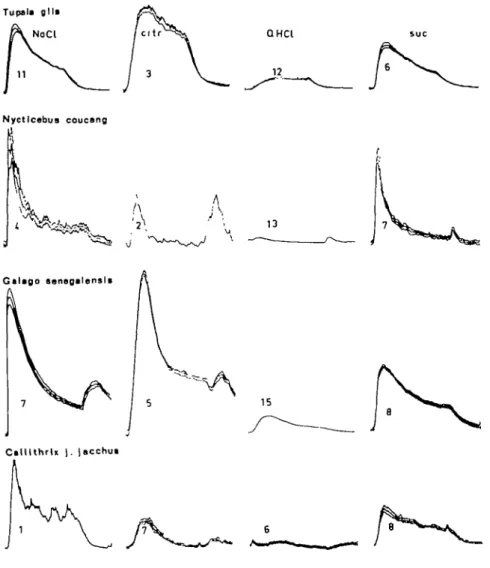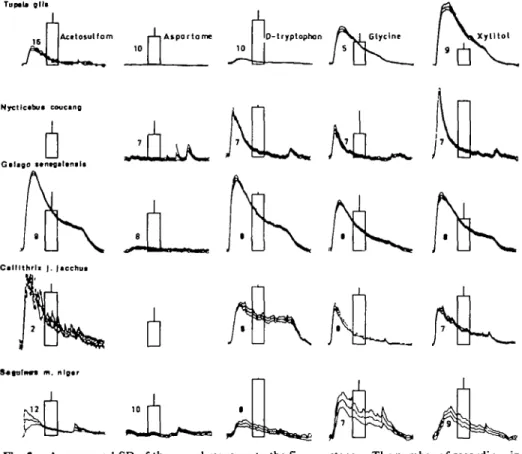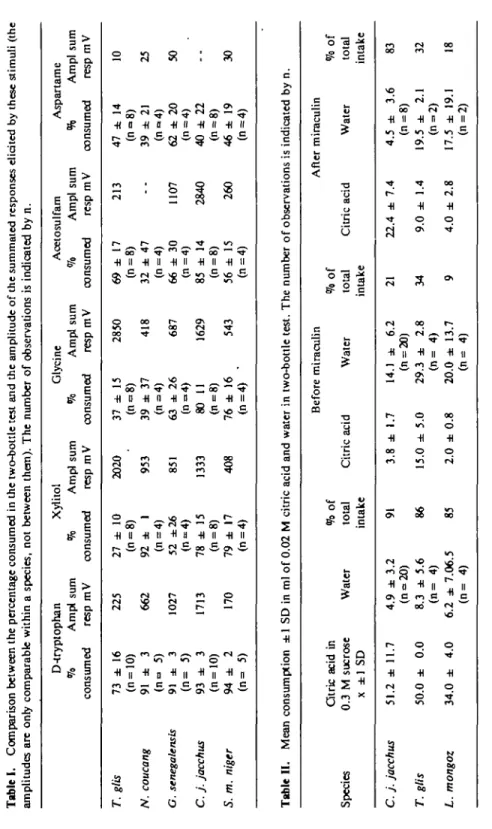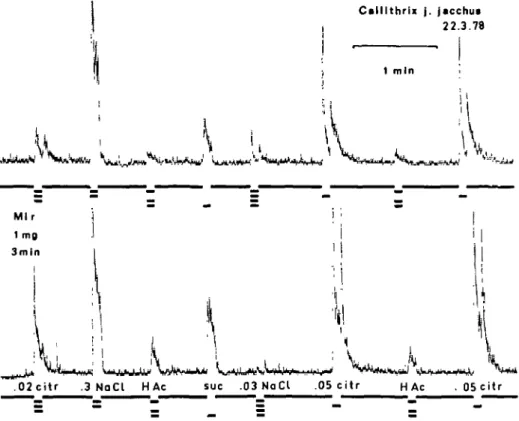Chemical Senses Volume 6 Number 3 1981
Gustatory responses in three prosimian and two simian primate
species (Tupaia glis, Nycticebus coucang, Galago senegalensis,
Callithrix jacchus jacchus and Saguinus midas niger) to six
sweeteners and miraculin and their phylogenetic implications
G. Hellekant,1 D. Glaser,2 J. Brouwer3 and H. van der Wei3
^Department of Veterinary Science and Wisconsin Regional Primate Center, 1655 Linden Drive, Madison, WI53706, USA, %lnstitute of Anthropology, University
of Zurich, Switzerland, and 3 Unilever Research, Vlaardingen, Netherlands (Received December 1980; accepted September 1981)
Abstract. The intake of six sweeteners was recorded together with their effects on the impulse
activi-ty of the chorda activi-tympani proper nerve during their application to the tongue. The sweeteners were: acetosulfam, aspartame, D-tryptophan, glycine, xylitol and thaumatin. They were used at human equi-sweet concentrations. In all species, D-tryptophan was strongly preferred and gave a significant response, while aspartame and thaumatin gave neither a significant behavioral nor a significant neural response. Acetosulfam, glycine and xylitol elicited neural responses, but their behavioral effects dif-fered from a rejection in some species to a preference in others. Miraculin, which has a sweetness in-ducing effect in man, showed this effect only in the platyrrhinean species and not in the prosimian.
Introduction
From an evolutionary point of view the primate order can be compared with a tree that divides into two major branches, a prosimian and a simian one. A perhaps more well-known name of the prosimians is "half-monkeys" in contrast to the simians which are considered to be "real" monkeys. The simians in their turn are divided into a catarrhine or Old World branch which includes man and a platyrrhine branch comprising the species of the New World.
Each species has characteristics which separate it from other species. This is true for the sense of taste in general, but has perhaps been best substantiated for the sweet taste. Thaumatin serves as a good example. It is to man about 2,000 times sweeter than sucrose on a weight basis, but seems to have no sweet taste to some other primates.
However, the ability to taste thaumatin does seem to follow evolutionary lines. This is at least the case in the 34 different primates we have studied up until now (Glaser et al., 1978). Thus, thaumatin seems to taste sweet only to catarrhine species and not to the platyrrhines and prosimians. In most species we only have behavioral observations at the present time. This is also the case for 4 of the 5 species reported here. Therefore it is of value to supplement the earlier behavioral observations with recordings from the chorda tympani proper nerve (CT). This is one purpose of this study.
Since it is likely that phylogenetic differences also exist for other sweeteners, this study will present behavioral and electrophysiological observations for five other sweeteners. These are: acetosulfam (acesulfame-K) and aspartame, both of
which are more than 100 times sweeter than sucrose; D-tryptophan, which is at least ten times sweeter than sucrose; glycine, which is slightly sweeter than sucrose; and finally xylitol which, although it is slightly less sweet than sucrose, is used as sweetener in several products, and therefore is of interest. As will be shown in the following, it is probable that one of them does not taste sweet at all to the primates in this study.
Miraculin is another substance whose effects seem to follow evolutionary lines. Miraculin has no sweet taste in itself, but acts as a very potent taste modifier in man by adding a sweet taste to all sour tastes after the tongue has been exposed to it (Brouer et al., 1968). Previously we have recorded similar effects in some si-mian species but nothing has been reported of its effects in prosisi-mian species. This study will present behavioral and electrophysiological observations of the ef-fect of miraculin.
We will also include recordings of the CT to the four taste qualities, represented by sucrose, sodium chloride, quinine hydrochloride and citric acid, since they serve as standards in taste research.
Methods
The neurophysiological recordings were made under general anesthesia. A combination of Sernylan® and Mebumal® was used as initiation, while the anesthesia was maintained with Mebumal. The chorda tympani proper nerve was dissected after tracheotomy and insertion of an i.v. cannula. The impulse activity of the nerve was recorded under mineral oil, amplified and displayed, summated and recorded on a Statos I recorder and a Med-80 computer system as described elsewhere (Hellekant et al., 1980). The taste stimuli came from bottles housed in a thermostatically controlled bath. The flow from the bottles was controlled by magnetic valves which could be opened in any order. The selected stream was directed onto the tongue by a small lucite channel just above the tongue. In the neurophysiological experiments the tongue of the animal was stimulated for about 5 sec. Each stimulation was preceded and followed by water so that the tongue was bathed continuously.
Solutions of 0.3 M NaCl, 0.001 M quinine hydrochloride, 0.02 M citric acid and 0.3 M sucrose served as representatives of the four basic taste qualities. In an attempt to use equi-sweet solutions, we applied data obtained in human taste ex-periments. Therefore, 0.70 g acetosulfam, 0.53 g aspartame, 66.68 g glycine, 2.98 g D-tryptophan and 115 g xylitol were dissolved per liter solution. Finally, solu-tions of 0.01% thaumatin were used. One mg of miraculin, dissolved in 0.5 ml of water, was applied on the tongues of the species in which it had not been tried before. The miraculin was left on the tongue for 3 min as in earlier studies. Ex-cept for T. glis, of which two animals were available, one individual of each species was available and used.
Behavioral experiments with the 6 sweeteners were carried out in 9 C j . jac-chus, 3 S. m. niger, 2 T. glis, 2 Lemur mongoz, oneN. coucang and G. senegalen-sis each with a two-bottle preference test. The solutions were offered to the noc-turnal species for about 14 h and to the others for about 8 h in four sessions. When miraculin was tested it was given to each animal in a slice of a banana
Gustatory responses In primates to six sweeteners and ralraculin
which had been soaked for about one min in 5 mg miraculin dissolved in one ml of water. The same miraculin was used on all animals, with citric acid before and after miraculin. Before and after the miraculin, bottles containing 0.02 M citric acid and water, respectively were offered to the animals for 4-6 h. A mixture of 0.3 M sucrose in 0.02 M citric acid served as control.
Results
The neural response to the four taste qualities
Figure 1 presents averaged summated responses of the CT nerves of, from the top, T. glis, N. coucang, G. senegalensis and C. j . jacchus during stimulation with, from the left, 0.3 M NaCl, 0.2 M citric acid, 0.001 M quinine and 0.3 M sucrose. All records were obtained during an 8.2 sec long recording period, which began when the flow over the tongue was changed from water to a stimulus. After 5-6 sec the flow was switched back to water.
As can be seen, each record of Figure 1 is composed of three traces. The middle trace shows the average and the two other ±1 standard deviation (SD). The figures in the records indicate the number of recordings on which each average is based.
It is evident from Figure 1 that the salt solution gave the largest response in N. coucang and C. j . jacchus while the acid seemed to be the best stimulus in T. glis and G. senegalensis. The dominance of salt as the most powerful stimulus in N. coucang is further illustrated by the fact that we had to use a 0.15 M solution in-stead of 0.3 M. The response to the stronger solution was so large that it saturated the A/D converter at the sensitivity used.
From the point of view of the general sensitivity to sweet in primates it can be noticed that the sucrose solution elicited a good response in all four species. Since the response in S. m. niger to the four taste qualities has been presented before (Hellekant et al., 1976), it was not included here.
Behavioral and electrophysiological effects of five sweeteners
The intake (columns) and the CT responses (traces) to these five sweeteners are presented in Figure 2. The nerve records were obtained in the same way as described above. All stimuli except aspartame seemed to elicit a significant response which indicates that they have a taste.
The hedonic effects of these stimuli are shown in the columns. They illustrate the intake of each solution in percent of total intake of solution and water.
These percentages and the maximum amplitudes of the averaged responses are listed in Table I. Due to computer error two values are missing. But from the values of Table I it seems as if the ability of aspartame to stimulate the taste buds of these non-human primates was small if not absent. The amplitudes are only comparable within a species, not between them.
The electrophysiological effect of thaumatin
Solutions of 0.01% thaumatin were applied to the tongue while the CT nerve activity was recorded. In no species did we obtain a change of the nerve activity.
Nyctlcebus coucang 1)
Fig. 1. Averages of sum mated chorda tympani nerve responses ± 1 SD to solutions of sodium chloride, citric acid, quinine hydrochloride and sucrose in the species investigated. The figure beneath each recording gives the number of samples in each average.
The electrophysiological and behavioral effect of miraculin
Figure 3 shows a recording from the only species, C. j . jacchus, in which we observed an enhancement of the responses to acids after miraculin. In this species the responses to 0.02 M citric acid were 2 — 4 times, to 0.05 M citric acid at least 1.5 times and to 0.006 M acetic acid 2-2.5 times larger after than before, while the responses to 0.3 M NaCl were about the same and those to 0.3 M sucrose were less than 1.5 times of the responses before miraculin.
In N. coucang the responses to 0.02 M citric acid were 1.5 times larger after miraculin than before, but the responses to the other sour stimuli were not enhanced. Thus, we conclude that miraculin did not enhance the responses to
Gustatory responses in primates to six sweeteners and miraculin
TupaU glli
ttosulfam r-L-i At par tame
--_
10
M
J !
Nrctlccbua coucang Callllhrli |. |icchui JLN
m. nlg«rFig. 2. Averages ± 1 SD of the neural response to the five sweeteners. The number of recordings in each average is indicated by the figures in each trace. The columns give the intake of the sweetener in question + 1 SD in percentage of the total intake.
acids in this species. With regard to the other species it was evident that their responses to acids were unaffected by miraculin.
Behavioral observations of the effect of miraculin obtained in a group of 9 C. j . jacchus, two T. glis and two L. mongoz are presented in Table II. In C.j. jac-chus, the citric acid constituted 21 % of total fluid intake before miraculin and 83% after. Although this last figure is slightly less than the 91% consumed of the mixture of sucrose and citric acid, it indicates a strong change of preference as the result of miraculin and corroborates the electrophysiological data of Figure 3. Similarly, behavioral results from T. glis corroborated the electrophysiological evidence; miraculin caused no change in their consumption of citric acid. The figures before and after miraculin were 34 and 32%, respectively. When the mix-ture of sucrose and citric acid was offered they consumed everything which amounted to 86% of the total consumption of fluid.
No animals of the other two prosimian species, N. coucang and G. senegalen-sis, were available for the behavioral experiments. However, in another prosi-mian species, L. mongoz., miraculin showed a similar absence of effects. Citric acid consumption was 9% before and 18% after miraculin, while, when the sucrose-citric acid mixture was offered, consumption was 85%.
Tabl e I . Compariso n betwee n th e percentag e consume d i n th e two-bottl e tes t an d th e amplitud e o f th e summate d response s elicite d b y thes e stimul i (th e amplitude s ar e onl y comparabl e withi n a species , no t betwee n them) . Th e numbe r o f observation s i s indicate d b y n .
T.glis N. coucang G. senegalensis C. j
. jacchus S. m. niger D-tryplopha n Xylito l % Amp l su m % Amp l su m consume d res p m V consume d res p m V Glycin e Acetosulfa m Aspartam e % Amp l su m % Amp l su m °h Amp l su m consume d res p m V consume d res p m V consume d res p m V 7 3 ± 1 6 (n = 10 ) 9 1 ± 3 (n ° 5 ) 91 ± 3 (n = 5 ) 9 3 ± 3 (n=10 ) 9 4 ± 2 (n = 5 ) 22 5 66 2 102 7 171 3 17 0 2 7 ± 1 0 (n = 8 ) 9 2 ± 1 (n=4 ) 5 2 ±2 6 (n-4 ) 7 8 ± 1 5 (n = 8 ) 7 9 ± 1 7 (n = 4 ) 202 0 95 3 85 1 133 3 40 8 3 7 ± 1 5 3 9 ± 3 7 (n=4 ) 6 3 ± 2 6 8 0 1 1 (n = 8 ) 7 6 ± 1 6 (n=4 ) 285 0 41 8 68 7 162 9 54 3 6 9 ± 1 7 (n = 8 ) 3 2 ± 4 7 (n=4 ) 6 6 ± 3 0 (n=4 ) 8 5 ± 1 4 (n = 8 ) 5 6 ± 1 5 (n=4 ) 21 3 110 7 284 0 26 0 4 7 ± 1 4 (n o 8 ) 3 9 ± 2 1 (n=4 ) 6 2 ± 2 0 (n=4 ) 4 0 ± 2 2 (n = 8 ) 4 6 ± 1 9 (n=4 ) 1 0 2 5 50 30
i
Tabl e II . Mea n consumptio n ± 1 S D i n m l o f 0.0 2 M citri c aci d an d wate r i n two-bottl e test . Th e numbe r o f observation s i s indicate d b y n . Specie s C. j . jacchus T. glis L. mongoz Citri c aci d i n 0. 3 M sucros e x ± 1 S D 51. 2 ± 11. 7 50. 0 ± 0. 0 34. 0 ± 4. 0 Wate r 4. 9 ± 3. 2 (n°20 ) 8. 3 ± 5. 6 (n = 4 ) 6. 2 ± 7.06. 5 (n = 4 ) %o f tota l intak e 91 86 85 Befor e miraculi n Citri c aci d 3. 8 ± 1. 7 15. 0 ± 5. 0 2. 0 ± 0. 8 Wate r 14. 1 ± 6. 2 (n = 20 ) 29. 3 ± 2. 8 (n = 4 ) 20. 0 ± 13. 7 (n = 4 ) %o f tota l intak e 21 34 9 Citri c aci d 22. 4 ± 7. 4 9. 0 ± 1. 4 4. 0 ± 2. 8 Afte r miraculi n Wate r 4. 5 ± 3. 6 (n = 8 ) 19. 5 ± 2. 1 (n = 2 ) 17. 5 ± 19. 1 (n = 2 ) % o f tota l intak e 83 32 18Gustatory responses in primates to six sweeteners and mlraculln
C a l l i t h r i i t j . j a c c h u * 22.3.78
. 0 2 c i t r .3 N o C l H Ac sue .03 N a C l . 0 5 c i t r H Ac . 05 c i t r
Fig. 3. Recordings before and after 1 mg miraeulin on the tongue for 3 min in C. j . jacchus. Except for acetic acid, which held a concentration of 0.006 M, the concentrations of the other stimuli are in-dicated in the recording. The recordings show that miraeulin enhanced the response in this simian species.
Discussion
It is perhaps necessary to point out that the species used here are difficult to ob-tain for experiments which necessitate sacrifice of the animals. Hence we can only report data from one individual of each species except T. glis. However, this may be justified because we present recordings from species not earlier recorded from and these observations may add data to understanding of the phylogenetic rela-tionship among primates.
This phylogenetic relationship is especially well demonstrated by thaumatin, which to man is extremely sweet. In an earlier study on 34 different primates (Glaser et al., 1978) we found with behavioral technique that species which do not belong to the catarrhine infraorder were indifferent to thaumatin, though they discriminated between water and sucrose.
In this study, which comprises non-catarrhine species, we did not record any increase of the CT activity to thaumatin. Thus, this study supplies elec-trophysiological data in support of the earlier study by Glaser et al. (1978) in-dicating that the ability to taste the sweetness of thaumatin is restricted to species belonging to the catarrhine infraorder.
The observation here that aspartame caused no change in the CT nerve activity and was neither rejected nor preferred in the two-bottle tests is along these lines. It may be suggested that possible unpleasant qualities of aspartame balanced its pleasant ones. However, judged from the experience of man, it has a pleasant sweet taste, more pleasant than glycine and D-tryptophan, which were preferred here. Further, aspartame is, according to Crosby (1976), a good substitute for sucrose. The crucial observation, however, is that aspartame caused no change in the CT activity, which means, if technical limitations were not the cause, that it elicited no taste.
The other possibility is that it may have tasted sweet at a higher concentration. This is possible but unlikely since studies by Sato et al. (1977) as well as our own observations show that all catarrhine species tested, can taste and like aspartame. Further, in those species aspartame at the concentrations applied here can be used as a substitute for sucrose in solutions of quinine, which otherwise would have been rejected.
There are two observations of the gustatory effects of aspartame in species less related to the catarrhine infraorder than those used here. Neurophysiological observations by Sato et al. (1977) and behavioral observations by Ninomiya (un-published) indicate that aspartame does not taste sweet to the rat.
It is tempting to suggest that in aspartame we have another sweetener which from a phylogenetic point of view shows characteristics similar to thaumatin, but it seems too early to draw that conclusion.
This may be true for miraculin too, whose effects seem to be restricted to si-mian primates. In this study we recorded an effect only in the species representing the simian infraorder, C. j . jacchus, but not in those representing the prosimian, N. coucang, G. senegalensis and T. glis. Miraculin is effective in S. m. niger, which is a simian species (Hellekant et al., 1976). Also our behavioral ex-periments with L. mongoz indicate that miraculin has no effect in that prosimian species.
Results corroborative with this idea have earlier been obtained in some other si-mian species like Cercopithecus aethiops and Macaca fascicularis (Hellekant et al., 1974) and Macaca mulatto (Hellekant, 1977). In the non-primates species tried earlier, rat (Diamant et al., 1972) as well as dog, pig and rabbit (Hellekant,
1976), we have recorded essentially no effect of miraculin.
Thus, the results of these behavioral and electrophysiological experiments sup-port the notion that miraculin has no effect on the taste of sour substances in pro-simian primates and non-primate species, while it elicits taste modifying effects in simian monkeys.
In summary, it seems that the results here further stress the diversity among mammals with regard to their sweet taste, but also further show that there are phylogenetic relationships, because, judged from available data, thaumatin and aspartame seem to taste sweet only to catarrhine, and miraculin has a sweet enhancing effect only in simian species.
Gustatory responses In primates to six sweeteners and miraculin
References
Broirwer, J.N., van der Wei, H., Francke, A. and Henning, G.J.: 1968, 'Miraculin, the sweetness-inducing protein from miracle fruit', Nature, 220, 373-374.
Crosby. G.A.: 1976, 'New sweeteners', Critical Reviews in Food Science and Nutrition, 297-323. Daimant, H., Hellekant, G. and Zotterman, Y.: 1972, 'The effect of miraculin on the taste buds of
man, monkey and rat', in D. Schneider (ed.), Olfaction and Taste IV, Wissenschaftliche Verlagsgesellschaft mbH, Stuttgart, pp. 241-244.
Glaser, D., Hellekant, G., Brouwer, J.N. and van der Wei, H.: 1978, 'The taste responses in primates of the proteins thaumatin and monellin and their phylogenetic implications'. Folia Primatol., 29, 56-63.
Hdlekant, G.: 1976, 'On the gustatory effect of gymnemic acid and miraculin in dog, pig and rabbit',
Chan. Senses Flavor, 2, 85-95.
Hellekant, G.: 1977, 'Effects of miraculin and gymnemic acid in the rhesus monkey (Macaca
mulat-to), in Food Intake and Chemical Senses, eds. Katsuki.Y., Sato.M., Takagi.S.F. and Oomura.Y.
pp. 201-210.
Hellekant, G., Hagstrom, E.C., Kasahara, Y. and Zotterman, Y.: 1974, 'On the gustatory effects of miraculin and gymnemic acid in the monkey', Chem. Senses Flavor, 1, 137-145.
Hellekant, G., Glaser, D., Brouwer, J.N. and van der Wei, H.: 1976, 'Gustatory effects of miraculin, monellin and thaumatin in the Saguinus midas tamarin monkey studied with electrophysiological and behavioural techniques', Ada Physiol. Scand., 97, 241-250.
Hdlekant, G., Aronsson, T. and Karlbom, U.: 1980, 'Neural (electrophysiological) methods in chemoreception research', J. Anim. Physiol. Anim. Nutrit. Suppl., 11, 21-26.
Sato, M., Hiji, Y., Ito, H., Imoto, T. and Saku, C : 1976, 'Properties of the sweet taste receptors in macaque monkeys', in Food Intake and Chemical Senses, Tokyo Press, pp 187-199.



